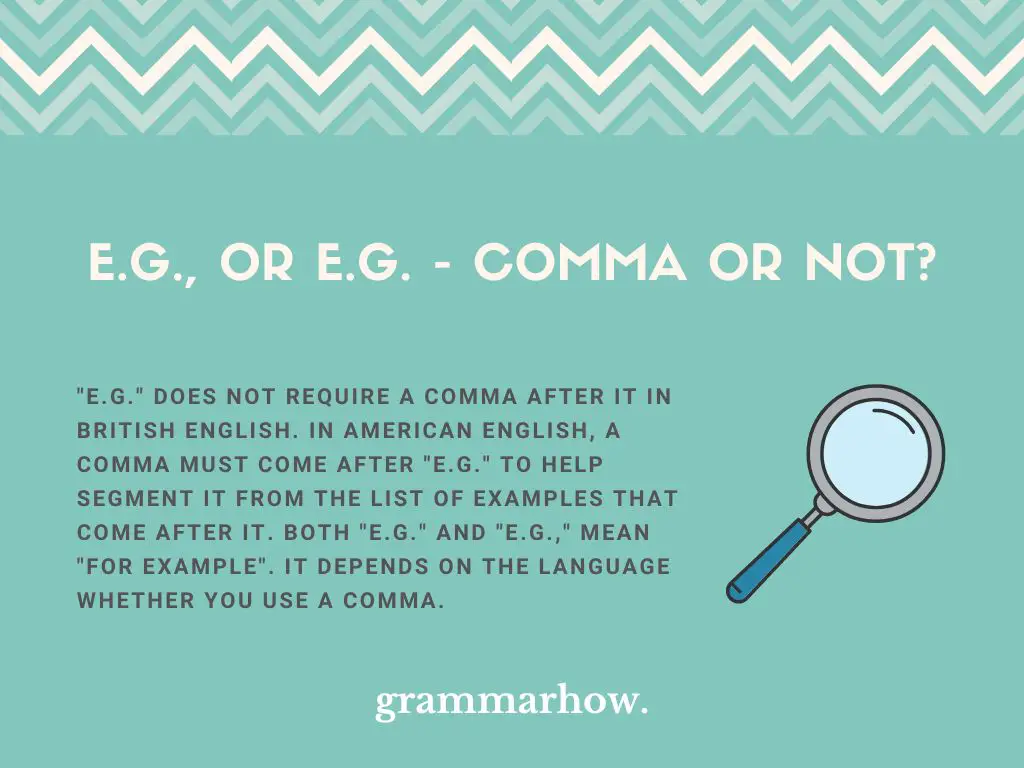Comma rules can vary based on what you’re writing about. Sometimes, you might require a comma after “e.g.,” and other times, you might not. This article will explore how to use commas with “e.g.” in all situations.
E.g., or e.g. – Comma or Not?
“E.g.” does not require a comma after it in British English. In American English, a comma must come after “e.g.” to help segment it from the list of examples that come after it. Both “e.g.” and “e.g.,” mean “for example”. It depends on the language whether you use a comma.

American English writers would put it like this:
- There were many cases here (e.g., French and Bulgarian cases).
British English natives would write it like this:
- We saw many fish (e.g. clown fish and lobster).
E.g., or e.g. in the UK?
“E.g.” is always written without a comma in the UK. British English tends to follow AP Stylebook guidelines. According to AP Style, a comma is not required after “e.g.” when it introduces a list of examples.
“E.g.” is an abbreviation of “exempli gratia.” This is a Latin phrase that translates to “for example.” You do not need to include a comma after an abbreviation like this when writing in British English.
Here are some examples to show you how British English writers would include “e.g.:”
- There were many issues here (e.g. ones in the system, in the database, and on the back-end).
- You could have been more clear (e.g. by helping us understand the issues earlier than that).
- They mentioned a lot of problems (e.g. the ones that weren’t accounted for in the briefing).
- I told you we saw the monkeys, e.g. the chimps, gorillas, and the other ones.
- There was no room in the building for the girls (e.g. Sarah and Jessica).
“E.g.” never requires a comma when it’s used in British English.
E.g., or e.g. in the US?
American English users would include a comma after “e.g.” in all situations. This is commonplace because American English writers follow The Chicago Manual of Style. This stylebook teaches that commas should always come after “e.g.”
The reason a comma comes after it is because of the word it is abbreviating. “E.g.” is the abbreviation of “for example.” You should always include a comma after “for example:”
- I had many ideas. For example, I thought it would be wise to stop selling bad products.
Since “for example” requires a comma, it’s also true that “e.g.” requires one. American English users will always include a comma after “e.g.” to highlight this similarity with “for example.”
Here are a few examples to show you how the comma can be included:
- I did not think much about the problems (e.g., the ones that they told me about when I signed up).
- I like a lot of food, e.g., eggs, bacon, and sandwiches. Do you have anything to offer?
- I’m not going there because of the dangers, e.g., bears, wolves, and lions.
- She told me not to talk to you about those issues, e.g., the ones that seem to offend you the most.
- Can we start again with a different topic (e.g., politics or history)?
E.g., or e.g. in Other Countries?
Most of the time, if you want to learn what other countries do, you can refer to British English rules. Outside of the US, it’s common for countries like Australia and Canada to follow British English guidelines.
Both Australia and Canada leave the comma out of “e.g.” when including examples. It’s common for them to follow AP Style guidelines just like British English users do.
If in doubt, it’s best to avoid using the comma for countries outside of the US. Since it’s more likely that you’ll find a writer who isn’t using American English rules, the comma is not all that important to include.
Other Ways to Write “e.g.”
It would help to know of a few other ways to write “e.g.” in case some alternatives come up in people’s writing:
- Eg.
- Eg
- E.g
- For example
- Ex.
- As an example
Final Thoughts
You do not need to include a comma with “e.g.” when you aren’t writing in American English. Only American English writers include a comma after the abbreviation. It’s a style choice, but AP Style recommends leaving the comma out in most cases.

Martin holds a Master’s degree in Finance and International Business. He has six years of experience in professional communication with clients, executives, and colleagues. Furthermore, he has teaching experience from Aarhus University. Martin has been featured as an expert in communication and teaching on Forbes and Shopify. Read more about Martin here.

